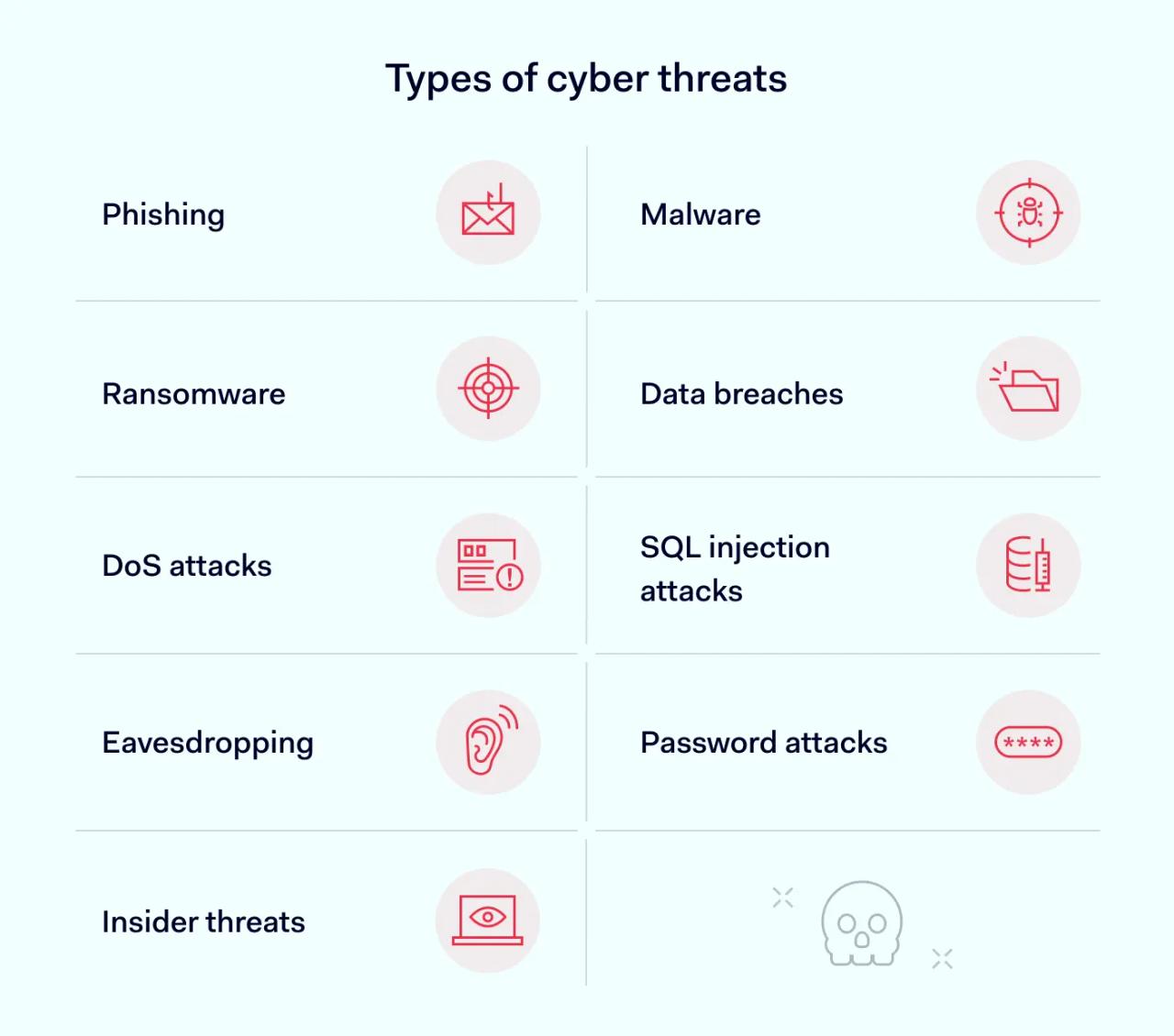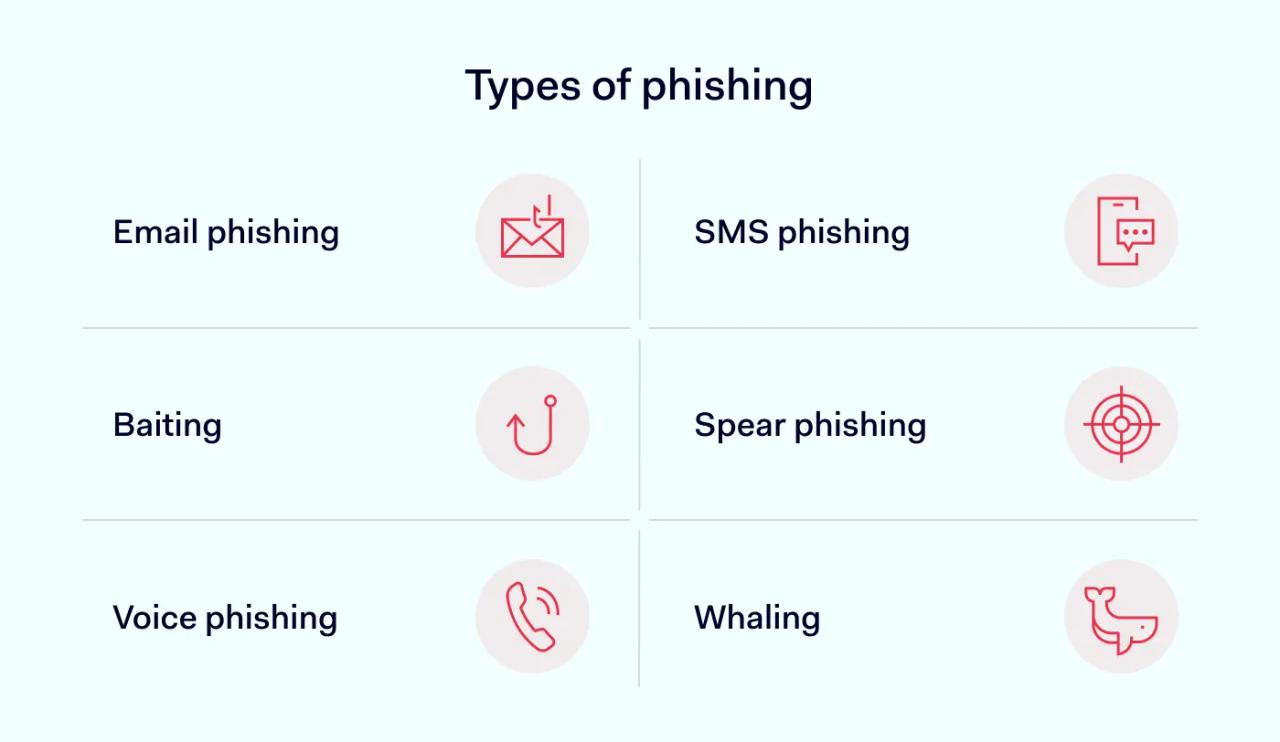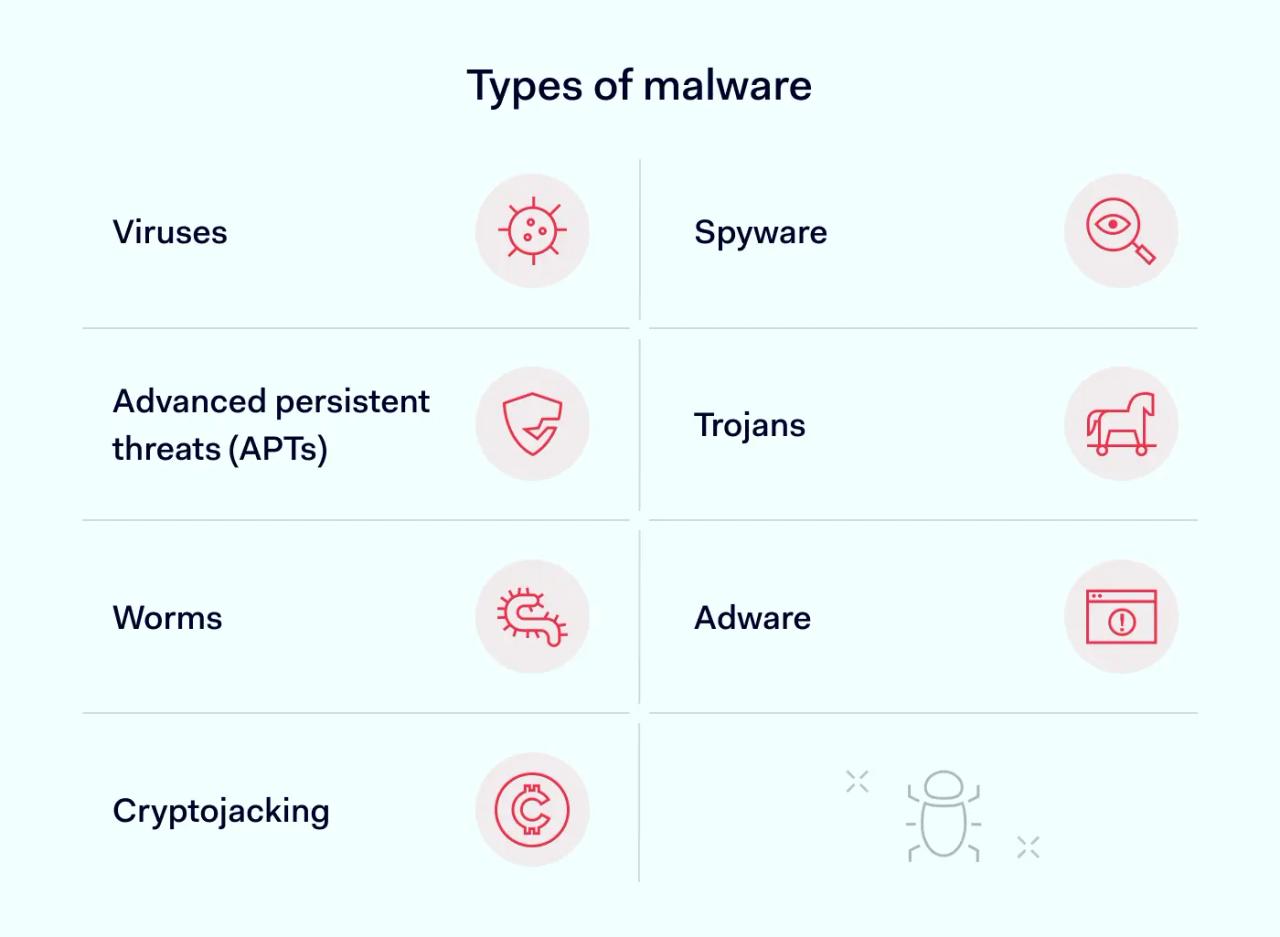Robust cybersecurity is a fundamental part of modern business. In 2023 alone, over 350 million individuals fell victim to data theft attacks, while the global cost of cybercrime is expected to surge in the next three years, rising from $9.22 trillion in 2024 to $13.82 trillion by 2028.
It's essential to take cyber threats seriously. This article explores what a cyber threat is and the main threat types.
Cyber threat definition
A cyber threat is a malicious activity that potentially compromises data security or systems integrity. Cyber threats generally originate outside affected organizations and aim to steal, extort, or disrupt targets.
Cyber threat examples include malicious software, phishing attacks, man-in-the-middle attacks, denial of service, and code exploits. Organizations should prepare to mitigate common attacks and implement appropriate security policies to protect their systems.
Security teams also need to refresh their knowledge and counter emerging threats. Cybersecurity continues to evolve fast, so staying informed is essential. Teams need to use the latest intelligence to create effective security strategies.
The main sources of cyber threats
Cyber threats can come from many sources, with both external and internal attackers. Common cyber-attack sources include:
- Criminal organizations. The most common source of cyber threat. Criminal organizations attack company networks to extort ransoms or extract data for sale on the dark web.
- Nation states. Some countries sponsor cyber-attackers for strategic reasons. Attackers may seek to damage enemy assets, steal confidential information, or create disorder within hostile nations.
- Insider threats. Hostile insiders may use their privileges to access sensitive data for sale or to damage the organization. Insider threats include current and ex-employees, as well as third parties.
- Terrorist groups. Terrorist groups may seek to damage infrastructure related to enemy states or inflict damage to disrupt everyday life in targeted countries.
Types of cyber threats
Companies need in-depth knowledge of potential cyber threats to implement effective security measures. Risk management teams should assess each cybersecurity threat listed below and put in place suitable threat mitigation solutions.

Phishing
One of the most common social engineering attacks, phishing attacks, persuade targeted individuals to take action that puts data at risk.
Skilled attackers use familiar communication tools like emails or websites to pose as legitimate actors. Targets download attachments or enter data into insecure online forms, leading to malware infections.
Mitigating social engineering attacks is difficult as human error is always present. It exploits human psychology, like trust, urgency, and curiosity, making technical solutions alone insufficient. One solution is integrating knowledge of phishing varieties into cybersecurity training.

Common varieties include:
- Email phishing. Attackers create emails from trusted partners or reputable companies asking targets to click malicious links or download attached files. Without thorough scrutiny of incoming emails, employees often see these messages as legitimate.
- Baiting. A popular phishing variant uses enticements to attract the attention of targets. Methods could include rewards or discounts from usually legitimate organizations.
- Voice phishing. Vishing uses phone calls to impersonate legitimate contacts. Callers often use detailed profiles to make conversations more credible.
- SMS phishing. Smishing involves sending malicious text messages to mobile devices.
- Spear phishing is a targeted form of social engineering. Attackers use databases of stolen data or publicly available information to profile targets and create tailored phishing content. They often impersonate colleagues or contacts, making them harder to detect.
- Whaling. "Whales" are high-value individuals, often at the C-suite level of targeted organizations. Attackers often pose as recruiters or fellow executives. Detailed information and urgent messaging persuade executives to misuse their extensive network privileges.
Malware
Malware attacks are cybersecurity threats that implant malicious software on targeted networks or devices. Implanted software has a specific function, such as extracting data or logging keystrokes. However, agents may become immediately active or persist for months or years before taking effect.

Generally speaking, malware attacks have three serious network security effects: compromising system integrity, stealing data, and making assets unavailable. As a result, protecting against malware infections is a cybersecurity priority.
There are many types of malware. Common variants include:
- Viruses. Viruses are malicious agents that replicate and spread to connected devices.
- Spyware. Spyware agents run in the background of user devices. They log user activity, potentially extracting personal and financial data.
- Advanced persistent threats (APTs). APTs may exist for years without detection. They include measures to evade detection and generally enable low-level data extraction or surveillance.
- Trojans. Trojans infect devices by copying the properties of legitimate applications. They use their concealed status to damage software or files.
- Worms. Worms replicate across network assets following the initial intrusion. They quickly infect large communities of devices, affecting performance and availability.
- Adware. Adware agents deliver unrequested ads to infected users. These cybersecurity threats rarely compromise data but can impact performance. Adware may also include links to malicious websites.
- Cryptojacking. Attackers implant malicious code to harness system resources. Resources become part of crypto-mining operations, with damaging effects on network performance.
Ransomware
Ransomware is a sub-variant of malware that locks targeted devices or applications until users pay a financial ransom. Ransomware cyber-attacks account for over 20% of all cyberattacks. Attacks of this kind can also be extremely costly, with payments averaging $3.2 million in 2024.
Ransomware attacks tend to follow a similar pattern. Attackers lock target systems and demand payment. When payment arrives, they supply a decryption key and restore access.
Understanding the different ransomware attack styles is crucial. Varieties include:
Supply chain attacks
These cyber-attacks target applications or services used by many clients. This technique expands the "blast radius" of a ransomware attack, spreading agents to as many companies as possible.
Targets are unaware that third-party services are compromised. This lack of clarity enables attackers to use code signing or malicious updates to deliver ransomware payloads. Unless vendors detect the attack quickly, users often trust partner software, with damaging consequences.
Ransomware-as-a-service (RaaS)
RaaS kits are designed by skilled cyber criminals and made available for use by other attackers. Users pay to access the RaaS platform. They can mount sophisticated attacks without in-depth technical knowledge.
Double and triple extortion attacks
In double extortion attacks, criminals lock systems and extract data to external locations. Triple extortion attacks go further, issuing threats to leak data unless targets pay an additional fee.
Data breaches
Data breaches are specific cyber threats that expose valuable data to thieves. In the USA, the average cost of a data breach reached $4.88 million in 2024. With such high costs, companies need specific strategies to protect confidential data and mitigate data security threats.
Companies also need a proactive approach to data breach mitigation. On average, it takes 194 days for companies to detect a data breach. In that time, businesses can lose vast amounts of customer data, leading to crippling reputational damage.
Common causes of data breaches include:
- Phishing and social engineering attacks
- Malware injection
- Malicious insiders
- Vulnerabilities from unpatched tools
- Stolen credentials
- Configuration errors
- Injection attacks
- Supply chain attacks
- Using untrusted devices on company networks
DoS attacks
Denial of service attacks seek to overwhelm targeted networks with traffic, leading to system outages and financial damage. Standard DoS attacks use a single device to direct traffic. This attack type is limited in scope and easy to trace and block.
A _Distributed_ DoS attack is more concerning. DDoS attacks use groups of compromised devices, called botnets, to send massive traffic. Attackers infect devices with malware to connect them without permission.
Botnets make DDoS attacks stronger by overwhelming networks with fake requests. They also hide the attack's origin, making it harder to trace.
Companies need proactive strategies to prevent infection. Traffic monitoring, filtering, and rate limiting can ease the stress of DDoS attacks, rendering them far less damaging.
Denial of service attacks also often affect organizations reliant on the Internet of Things (IoT). Botnets can exploit large communities of IoT devices that may rely on outdated firmware.
SQL injection attacks
SQL (Structured Query Language) is a database programming language used in website infrastructure and applications. SQL injection attacks leverage exposed data entry forms to inject malicious code and gain network access.
Poorly secured SQL forms allow cyber criminals access via simple queries. Attackers can bypass authentication portals and access data connected to the application. Without segmentation or data encryption, these cybersecurity threats can lead to data breaches and may damage sensitive databases.
Eavesdropping
Eavesdropping attacks let threat actors intercept traffic and steal information. Attackers position themselves in key network spots to capture data. These attacks often happen with insecure remote access or public internet use. Like other cyber threats, eavesdropping comes in different forms:
- Packet sniffing. Sniffers intercept unencrypted data packets at the network data layer. Attackers can extract unprotected data, enabling more damaging secondary attacks.
- Cross-site scripting. Also known as XSS, cross-site scripting injects malicious code into web applications. This code infects the browsers of application users. Attackers can then capture data such as session cookies or tokens, enabling hijacking attacks.
- Man-in-the-middle attacks involve attackers placing themselves between two connected devices or applications and intercepting traffic. These attacks could involve fake or compromised Wi-Fi networks that seem legitimate but lack the security functions needed to prevent MiTM attacks.
- Session hijacking. Attackers take control of a user's network session by compromising authentication tokens. When they control the token, attackers can impersonate authorized users and assume their network privileges.
- IP address spoofing Attackers obtain packet IP address data and use this information to impersonate legitimate traffic. Cybercriminals can pose as routers or servers, harvesting traffic passing through compromised devices.
- DNS spoofing. DNS translates website domain names into IP addresses. Attackers can spoof DNS addresses to pose as legitimate websites or redirect traffic from trusted sites to malicious websites. These fake sites can capture data about users or form part of phishing attacks.
Password attacks
Passwords are the front line of cybersecurity. If attackers compromise legitimate credentials, they can gain network access and inflict critical damage. The two most common forms of password attack are credential stuffing and brute forcing.
Credential stuffing
Credential stuffing is a form of password attack where cyber criminals seek to guess network login details.
Sophisticated credential stuffing attacks leverage stolen data to reduce the need for password queries. Users often rely on the same password for many services. Accordingly, security teams must monitor threat intelligence for leaked credentials. One stolen identity could lead to a network-wide data breach.
Organizations can only protect against password attacks by enforcing strong password hygiene and implementing multi-factor authentication (MFA).
Brute forcing
Brute forcing is less subtle. This type of password attack overwhelms authentication systems by attempting every possible password permutation.
The rise of automated tools and computational power has made it easier to mount brute-force attacks. However, successfully brute-forcing a well-defended network remains hard. Strong, regularly changed passwords are often enough to prevent attacks.
There is a third aspect to password attacks. Threat actors may gain access to encrypted password records or encryption keys. Security teams must store authentication data securely and change encryption keys regularly.
Insider threats
Sometimes, cyber threats come from within. Insider threats can be deliberate or accidental. For example, employees might ignore device security policies and leave work laptops in public locations. Poor device security could expose confidential data or result in device theft.
More worryingly, insiders can perpetrate attacks on company networks. These cybersecurity threats present unique risks because organizations often trust insiders by default. As a result, insider threats possess extensive privileges to access and extract sensitive data.
Businesses may also misunderstand the nature of “insiders.” Security systems may regulate access and authorization for regular employees without covering contractors, third parties, or ex-employees. Users may also misuse short-term privilege escalations to obtain access.
To mitigate these cyber threats, companies should enforce Zero Trust Network Access (ZTNA) concepts, namely the principle of least privilege. Together, these approaches limit user privileges and minimize access to valuable data.
How to protect your network against cyber threats
Businesses are responsible for securing their and customer data against the cyber threats discussed above. Security teams must assess each risk and understand how it can affect their network infrastructure. Securing data is challenging, but following best practices will help:
- Guard all network endpoints with MFA and enforce strong passwords.
- Use access management tools to apply the principle of least privilege. Allow access to essential resources and deny access to everything else.
- Secure remote access connections with VPN technology.
- Encrypt sensitive data at rest.
- Train all employees to identify and avoid social engineering attacks. Run workshops simulating common phishing strategies. Monitor threat intelligence to understand emerging techniques. Inform staff about suspicious emails or other communications.
- Regularly patch applications, operating systems, and firmware on network devices.
- Protect the network edge with firewall rules. Block unauthorized traffic by default.
- Create an incident response policy to respond to cyber threats. Document how to quarantine and contain threats while ensuring availability. Understand who to notify and your data security compliance responsibilities.
- Back up critical data regularly, ideally using secure external cloud storage.
Cybersecurity starts by understanding the threat landscape
All companies must secure critical data and protect against cyber threats. Security strategies should consider external and internal threat actors, assess risks, and implement measures to prevent unauthorized access.
The NordLayer Cybersecurity Learning Center provides a comprehensive introduction to contemporary network security threats. Use our library to develop your knowledge and explore the threats affecting your operations.
